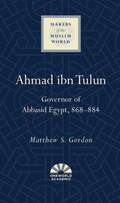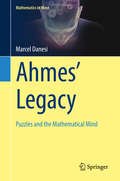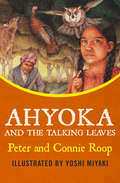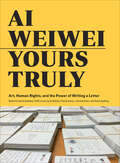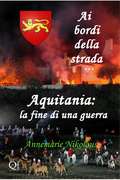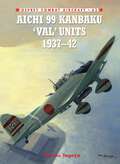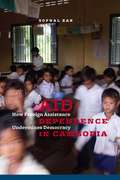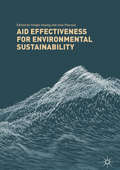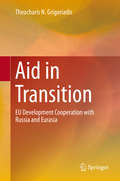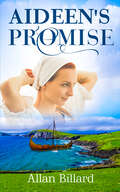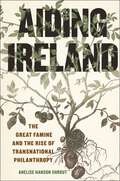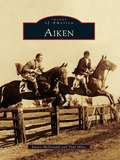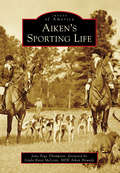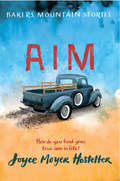- Table View
- List View
Ahmad al-Mansur: The Beginnings of Modern Morocco (Makers of the Muslim World)
by Mercedes García-ArenalSultan Ahmad al-Mansur (1578-1603) was one of the most significant rulers in the history of Morocco, which to this day bears the mark of his twenty-five year rule in the sixteenth century. A brilliant political and military tactician, cunning diplomat and descendent of the Prophet Muhammad himself, al-Mansur was a charismatic religious authority with ambitions to become Caliph and ruler of all Islam. Spanning four continents, this lucid introduction assesses this fascinating figure and his legacy amidst the political intrigue, colonial discovery, and military conquest that dominated the age. Mercedes García-Arenal is Professor of Arabic Studies at the Higher Council of Scientific Research in Madrid.
Ahmad ibn Tulun: Governor of Abbasid Egypt, 868–884 (Makers of the Muslim World)
by Matthew S. GordonAhmad ibn Tulun (835–884) governed Egypt on behalf of the Abbasid dynasty for sixteen years. An aggressive and innovative actor, he pursued an ambitious political agenda, including the introduction of dynastic rule over Egypt, that put him at odds with his imperial masters. Throughout, however, he retained close ties to the Abbasid house and at no point did he assert outright independence. In this volume, Matthew Gordon considers Ibn Tulun&’s many achievements in office as well as the crises, including the betrayals of his eldest son and close clients, that marred his singular career.
Ahmes’ Legacy: Puzzles And The Mathematical Mind (Mathematics in Mind)
by Marcel DanesiThis book looks at classic puzzles from the perspective of their structures and what they tell us about the brain. It uses the work on the neuroscience of mathematics from Dehaene, Butterworth, Lakoff, Núñez, and many others as a lens to understand the ways in which puzzles reflect imaginative processes blended with rational ones. The book is not about recreational or puzzle-based mathematics in and of itself but rather about what the classic puzzles tell us about the mathematical imagination and its impact on the discipline. It delves into the history of classic math puzzles, deconstructing their raison d’être and describing their psychological features, so that their nature can be fleshed out in order to help understand the mathematical mind.This volume is the first monographic treatment of the psychological nature of puzzles in mathematics. With its user-friendly technical level of discussion, it is of interest to both general readers and those who engage in the disciplines of mathematics, psychology, neuroscience, and/or anthropology. It is also ideal as a textbook source for courses in recreational mathematics, or as reference material in introductory college math courses.
Ahogados en la orilla: Grandes derrotas de la historia del deporte
by Carlos MolinaUn anecdotario de aquellos que se quedaron al borde de la gloria. A veces las derrotas son tan grandes que permanecen en la memoria más tiempo que las victorias. En la historia del fútbol todavía está presente el maracanazo, la imposible derrota de Brasil ante Uruguay (Mundial de 1950) en el estadio más grande del mundo, que provocó suicidios en todo el país. Muchos años después, en el otro extremo del planeta, otra extraordinaria derrota cambió la vida de Sudáfrica: los famosos All Blacks de Nueva Zelanda, los más poderosos jugadores de rugby del mundo, cayeron ante la anfitriona y sobre este grandioso fracaso se edificó el futuro de un país hasta ese momento dividido. En la mitología de los fracasos también está la recordada final de Berna entre la invencible Hungría de Puskas y una Alemania que empezó a forjar su leyenda sobre la ruina de los húngaros. Hay perdedores que están por encima de los triunfadores, como es el caso del ciclista francés Raymond Poulidor, que si hubiera ganado el tour de Francia no sería tan famoso y querido como lo es habiendo sido tres veces segundo y cinco veces quinto. En este libro está Chuck Wepner, el boxeador que perdió ante el gran Muhammad Alí, pero su combatividad inspiró a Sylvester Stallone para imaginar a Rocky Balboa. Está el aciago hoyo 18 de Jean van de Velde, el jugador de golf más desgraciado de la historia. Está la impotencia del ajedrecista Korchnoi ante Karpov. Y también figura el atleta alemán Lutz Long, cuya derrota ante Jesse Owens humilló al mismísimo Hitler. Y tantos otros que se quedaron al borde de la gloria, ahogados en la orilla.
Ahyoka and the Talking Leaves
by Peter Roop Connie Roop Yoshi MiyakeA Notable Social Studies Trade Book for Young People and recipient of the Florida Sunshine Award: In this absorbing chapter book, Ahyoka helps her father, Sequoyah, unlock the mystery of "talking leaves" to create the Cherokee alphabet Ahyoka is the daughter of Sequoyah, a silversmith who has given up most of his trade to focus on his true passion. He longs for the day when the Cherokee people can communicate to one another from afar and document the history of their lives. He wants his people--the Real People--to have a written language like the white men do. When he is ostracized from his community for the "magic" he is creating, he leaves his home to pursue his quest. His young daughter, who shares his dream, joins him on his journey. They work together to create a syllabic alphabet that will tell the story of the Cherokee people.
Ai Weiwei: Yours Truly
by Ai Weiwei Jasmine HeissA chronicle of the Chinese contemporary artist&’s interactive piece on prisoners of conscience, human rights, and the power of art and letter writing. Internationally renowned artist Ai Weiwei works at the intersection of art and politics. In 2014, he created @Large: Ai Weiwei on Alcatraz, an exhibition that engaged nearly 900,000 visitors in a conversation about human rights and freedom of expression. One of the artworks included was Yours Truly. This installation invited visitors to write postcards to prisoners of conscience around the world. On pre-addressed cards depicting the national birds and flowers of the countries where each prisoner was held, visitors wrote messages of hope, humor, and solidarity. In total, 92,829 postcards were written and sent. Ai Weiwei: Yours Truly delves into this astonishing project and invites you to engage with a work of art and a cause. Essays and a statement from the artists himself give a wider artistic and political context. In candid and heartfelt testimonials, five former prisoners and their loved ones—Ahmed Maher, Irom Sharmila Chanu, John Kiriakou, Chelsea Manning, and the family of Ebrahim Sharif Al Sayed—reflect on experiences of activism and detainment, and share the impact of receiving hundreds of postcards from people they would never meet. And photographs from the exhibition show the ordinary people who participated in the projects and some of the messages they wrote. This book is a visually stunning document, an inspiring call-to-arms, and a testament to the power of art to transform lives.
Ai bordi della strada...: Aquitania: la fine di una guerra
by Annemarie NikolausIl primo libro di una serie di mete turistiche francesi straordinarie e poco conosciute. Ai bordi della strada... ci sono manifestazioni e luoghi poco conosciuti che meritano una fermata intermedia. Il libro presenta uno dei maggiori eventi estivi d'Aquitania e fornisce uno sguardo più approfondito sul contesto storico ripreso dall'evento, riportato in vita in modo incomparabile: la rievocazione dell’ultima battaglia della Guerra dei Cent’anni sulle rive della Dordogna. È la fine di una guerra e di un'epoca. Una manifestazione estiva per coloro che sono in vacanza nel sud-ovest della Francia o sulla costa atlantica. Consigli aggiuntivi su cosa vedere nei dintorni. Con foto messe a disposizione dagli organizzatori. Contenuto: La bataille – La rappresentazione La Guienna inglese La battaglia storica La fine della strategia di guerra cavalleresca Da vedere nei dintorni di Castillon-la-Bataille
Aias
by SophoclesAmong the most celebrated plays of ancient Athens, Aias is one of seven surviving dramas by the great Greek playwright, Sophocles, now available from Harper Perennial in a vivid and dynamic new translation by award-winning poet James Scully. Still powerful and remarkably timely thousands of years after its creation, Aias is the moving story of a soldier returning home victorious from the Trojan War, only to discover he has lost his life’s purpose. This is Sophocles, vibrant and alive, for a new generation.
Aias
by SophoclesSophocles' play is a famous retelling of Aias's (Ajax's) demise. After the armor is awarded to Odysseus, Aias feels so insulted that he wants to kill Agamemnon and Menelaus. Athena intervenes and clouds his mind and vision, and he goes to a flock of sheep and slaughters them, imagining they are the Achaean leaders, including Odysseus and Agamemnon. When he comes to his senses, covered in blood, he realizes that what he has done has diminished his honor, and decides that he prefers to kill himself rather than live in shame.
Aichi 99 Kanbaku 'Val' Units
by Jim Laurier Osamu TagayaThe Aichi Type 99 Carrier Bomber (D3A) - code named 'Val' by Allied intelligence - was the mainstay of the Imperial Japanese Navy's carrier dive-bomber force from 1941 to 1943. It sank more Allied warship tonnage than any other Axis aircraft during World War II (1939-1945). While the Val's participation in the major carrier battles has been widely covered in other English language sources, details of its operations have received scant attention in English. This book explores the Val's combat operations. Colour illustrations and photographs complement the development of dive-bombing methods in the IJN.
Aid Dependence in Cambodia: How Foreign Assistance Undermines Democracy
by Sophal EarInternational intervention liberated Cambodia from pariah state status in the early 1990s and laid the foundations for more peaceful, representative rule. Yet the country's social indicators and the integrity of its political institutions declined rapidly within a few short years, while inequality grew dramatically. Conducting an unflinching investigation into these developments, Sophal Ear reveals the pernicious effects of aid dependence and its perversion of Cambodian democracy.International intervention and foreign aid resulted in higher maternal (and possibly infant and child) mortality rates and unprecedented corruption by the mid-2000s. Similarly, in example after example, Ear finds the more aid dependent a country, the more distorted its incentives to develop sustainably. Contrasting Cambodia's clothing sector with its rice and livestock sectors and internal handling of the avian flu epidemic, he showcases the international community's role in preventing Cambodia from controlling its national development. <P><P>A postconflict state unable to refuse aid, Cambodia is rife with trial-and-error donor experiments and their unintended consequences, such as bad governance and poor domestic and tax revenue performance—a major factor curbing sustainable, nationally owned growth. By outlining the terms through which countries can achieve better ownership of their development, Ear offers alternatives for governments still on the brink of collapse, despite ongoing dependence on foreign intervention and aid.
Aid Effectiveness for Environmental Sustainability
by Unai Pascual Yongfu HuangThis collection examines the role that foreign aid can play in dealing with the severe global challenge of climate change, one of the most pressing international development issues of the 21st century. Addressing the key threats of rising temperatures, changes in precipitation, coastal erosion and natural disasters, the book considers the implications for policy and future research, particularly in developing countries. Focusing on the worth of foreign aid in ensuring environmental sustainability, this collection consider how it can be used to improve access to sustainable energy, to promote efficient use of energy resources, to improve emission reduction and support the preservation of biodiversity in forests. Advancing our knowledge about foreign aid and climate change, it provides policy recommendations for the donors and recipient country governments. A cutting edge text on one of the most pressing international development issues of this century, this is key reading for all scholars of international development and climate change.
Aid for Elites
by Mark MoyarCurrent foreign aid programs are failing because they are based upon flawed assumptions about how countries develop. They attempt to achieve development without first achieving good governance and security, which are essential prerequisites for sustainable development. In focusing on the poorer members of society, they neglect the elites upon whose leadership the quality of governance and security depends. By downplaying the relevance of cultural factors to development, they avoid altering cultural characteristics that account for most of the weaknesses of elites in poor nations. Drawing on a wealth of examples from around the world, the author shows that foreign aid can be made much more effective by focusing it on human capital development. Training, education, and other forms of assistance can confer both skills and cultural attributes on current and future leaders, especially those responsible for security and governance.
Aid in Transition: EU Development Cooperation with Russia and Eurasia
by Theocharis N. GrigoriadisThis book is the one of the first to address aid effectiveness as a political and comparative economics question. Since the collapse of the Soviet Union and the transition of its republics to market structures and more representative forms of government, the European Commission has recognized the necessity of a closer economic cooperation with Russia, Ukraine and Kazakhstan, the three largest economies of the former Soviet Union. This book suggests that the foreign aid of the European Union provided a set of reform incentives to post-Soviet planners. It created the grounds for the institutional and social transformation of the bureaucracy at both central and regional levels by integrating it into the aid allocation process. In Russia, Ukraine and Kazakhstan, the observed subordination of NGOs to the developmental priorities of the bureaucracy occurred at the expense of diversity and political openness. Nevertheless, this reality led to the emergence of transnational sovereignty partnerships that reduced poverty for the general population and motivated both bureaucrats and entrepreneurs to cooperate. Empirical models alone are not sufficient to delineate all the aspects of principal-agent relationships in post-Soviet bureaucracies. This is why formal modeling and analysis of qualitative data are extremely useful. Evaluation reports indicate the problems and challenges faced by aid bureaucrats and suggest that the weakly institutionalized environments of Ukraine and Central Asia/Kazakhstan are less conducive to aid effectiveness than the heavily bureaucratized environment of Russia. The proposed incentives system for the allocation of foreign aid links EU foreign policy with bureaucratic decision-making and reflects the choice sets of the donor and the recipient. Multilevel definitions of aid effectiveness are provided in the course of the book chapters.
Aid, Peacebuilding and the Resurgence of War
by Sarah HoltAs one of South Asia's oldest democracies Sri Lanka is a critical case to examine the limits of a liberal peace, peacebuilding and external engagement in the settlement of civil wars. Based on nine years of research, and more than 100 interviews with those affected by the war, NGOs, and local and international elites engaged in the peace process.
Aideen's Promise
by Allan BillardHow was a discharged woman from a fishing village on the west coast of Ireland able to find and market an unending supply of choice seafood from Vinland… long before Columbus or Cabot ever ‘discovered’ the New World? She exhibited the spunk of a proto-feminist, unheard-of in the year 1249. Ultimately, she contrived a mission to defeat the thieves who wanted to keep the fishing grounds secret and opened the doors of the most valuable fishery ever known. She changed the history of our world.
Aiding Ireland: The Great Famine and the Rise of Transnational Philanthropy (The Glucksman Irish Diaspora Series)
by Anelise Hanson ShroutLooks at the ways that disparate groups used Irish famine relief in the 1840s to advance their own political agendasFamine brought ruin to the Irish countryside in the nineteenth century. In response, people around the world and from myriad social, ethnic, and religious backgrounds became involved in Irish famine relief. They included enslaved Black people in Virginia, poor tenant farmers in rural New York, and members of the Cherokee and Choctaw nations, as well as plantation owners in the US south, abolitionists in Pennsylvania, and, politicians in England and Ireland. Most of these people had no personal connection to Ireland. For many, the famine was their first time participating in distant philanthropy.Aiding Ireland investigates the Irish famine as a foundational moment for normalizing international giving. Anelise Hanson Shrout argues that these diverse men and women found famine relief to be politically useful. Shrout takes readers from Ireland to Britain, across the Atlantic to the United States, and across the Mississippi to Indian Territory, uncovering what was to be gained for each group by participating in global famine relief. Aiding Ireland demonstrates that international philanthropy and aid are never simple, and are always intertwined with politics both at home and abroad.
Aiding the Enemy
by Julie RoweBook three of War GirlsGerman-occupied Brussels, BelgiumDecember 1915Rose Culver is in grave danger. For months the Red Cross head nurse has been aiding Allied soldiers caught behind enemy lines, helping them flee into neutral Netherlands. It's only a matter of time until she's caught. Which makes it the wrong time to fall in love with a handsome German military doctor as devoted to the sanctity of human life as she is.The Great War has caused Dr. Herman Geoff to question everything he once believed. He knows Rose has been hiding British soldiers in her hospital-he's even treated some of them, refusing to go against his own Hippocratic oath. As a doctor, he admires Rose's skill and conviction. As a man, he can no longer deny his attraction to her. But when Rose is arrested for treason, Herman must choose between love for her and duty to his country...For more tales of love and war, download Saving the Rifleman and Enticing the Spymaster, available now! 32,000 words
Aiken
by Paul Miles Janice McdonaldIt seems unlikely that a place as far off the beaten track as Aiken, South Carolina, would become the preferred wintering location for the denizens of New York society. But from the late 1800s, the most recognized names in America--the Vanderbilts, the Whitneys, and even the Roosevelts--began coming to this charming Southern city to escape the cold, relax among the oaks, and play. And play they did, establishing Aiken as an international polo capital and a premier place to ride, hunt, and golf. Aiken has so much history beyond the folks known as the winter colonists. Legends of the area's restorative powers date back to Native Americans. Aiken also boasts an amazing number of records, including the destination for the world's longest railroad in 1833 and the second-oldest 18-hole golf course in the United States, the Palmetto Golf Club, built in 1892.
Aiken Thoroughbred Racing Champions (Sports)
by Lisa J. HallSince the 1940s, forty racing champions have traveled the hallowed grounds at the historic Aiken Training Track. Thoroughbred icons such as Kelso, Tom Fool, Swale, Pleasant Colony, Conquistador Cielo and Shuvee trained at this world-renowned track. Numerous members of the Aiken Thoroughbred Racing Hall of Fame won the biggest races in the sport. These champions combined for a total of 546 wins in 1,395 starts, including wins in the Kentucky Derby, the Preakness Stakes and the Belmont Stakes. Race along with author Lisa J. Hall as she pays homage to these equine champions and an Aiken legacy.
Aiken's Sporting Life (Images of America)
by Jane Page Thompson Linda Knox McleanIn 1869, newspaper articles touted Aiken as a health and pleasure resort with the world's largest wooden hotel. Swirling social life and sporting action continued during the war years, when the women of society carried on local traditions. In 1950, Aiken was bustling with scientists and engineers who relocated to work at the Savannah River Site. The last half of the 20th century saw swelling crowds at polo matches, steeplechase races, fox hunts, golf courses, and cultural amusements. In the early 21st century, many Aiken sporting traditions mark milestone anniversaries. At the center of everything is Hitchcock Woods, a woodland paradise, pine-topped cathedral, and equestrian playground that remains open year-round. The Hitchcock Woods Foundation was established to safeguard this treasure within the heart of Aiken. The Aiken Horse Show, held each spring, and Blessing of the Hounds, held on Thanksgiving, are two of the most revered of Aiken's sporting traditions.
Aikido Ground Fighting: Grappling and Submission Techniques
by Carl Long Walther G. Von Krenner Ken Jeremiah Damon ApodacaAikido Ground Fighting presents effective ground techniques that remain true to aikido founder Morehei Ueshiba's teachings while addressing a potential weakness in the system: while aikido is renowned for its submission and compliance techniques as well as grappling from a standing position, it is not known for its effectiveness when it comes to ground fighting. Aikido Ground Fighting is a unique look at the roots of aikido techniques (in particular, the kneeling practices of suwari-waza) and how they might be applied to defense on the ground. Written by a direct student of Morihei Ueshiba in collaboration with other aikido teachers, this book remains steadfastly true to the founder's teachings while presenting innovative and effective techniques. Containing never-before-published pictures of Ueshiba as well as step-by-step photographs clearly demonstrating techniques, Aikido Ground Fighting is designed for aikido students looking to become more well-rounded martial artists as well as practitioners of all martial arts seeking effective self-defense techniques.From the Trade Paperback edition.
Aikkiya Naadugal Sabai
by D. I. RavindranThis book presents a full length picture of United Nations Organizations--its birth/formation, members, powers, functions, etc. and tells how this international organization is working to fulfill its stated aims such as facilitating cooperation in international law, international security, economic development, social progress, human rights, and achievement of world peace etc. It also serves a text book of history on U.N.O.
Ailes, Nuages et Tourbillons: La mécanique des fluides en France de 1900 à 1950 - Une politique nationale (Science Networks. Historical Studies #61)
by François CharruFrench aeronautics shone brightly in the first decade of the twentieth Century, but declined after the Great War. To remedy this situation, a new Ministry of Air launched in 1929 a large national program of scientific research in fluid mechanics, including the creation of four institutes and five teaching centers in the faculties of sciences in Paris and the provinces. This visionary policy, supported by considerable means, started a quite creative period and led to important achievements notably in the fields of atmospheric turbulence, thermoconvection and wake vortices. The usual picture of a period exclusively dominated by German and British contributions (and growing North-American ones), comes out significantly revised. The fruits of this policy will allow France to play a major role in the creation, after World War II, of the International Union of Theoretical and Applied Mechanics, and are still visible today in the French teaching and research organization. Based on original materials unearthed from a variety of archival sources and scientific papers, the present book recounts this history in all its intertwined scientific, industrial, political and cultural dimensions.Peer-review recommendation: “The text is tremendously well written, and it remains clear and accessible even in its most scientifically advanced dimensions. The author is thus able to address both connoisseurs of the field, who will enjoy reading - and discovering not only scientific but also literary elements and references - and neophytes who are never left by the wayside as the chapters progress. An exceptional and original iconography usefully completes this picture, without overloading it.”L'aéronautique française, qui a tant brillé au début du XXe siècle, décline nettement après la Grande Guerre. Afin de redresser la situation, un nouveau ministère de l'Air lance alors, en 1929, un ambitieux programme en faveur de la recherche en mécanique des fluides, incluant la création de quatre instituts et cinq centres d'enseignement dans les facultés des sciences de Paris et de province. Cette politique visionnaire, dotée de moyens considérables, initie une période très dynamique et créative, en particulier dans les domaines de la turbulence atmosphérique, de la thermoconvection et des tourbillons de sillage. L'image d'un demi-siècle exclusivement dominé par les contributions allemandes et anglaises (et ensuite américaines) s'en trouve notablement transformée. Les fruits de cette politique permettront à la France de jouer un rôle majeur dans la création, après la Seconde Guerre mondiale, de l'Union internationale de mécanique théorique et appliquée, et demeurent visibles aujourd'hui encore dans les structures d'enseignement et de recherche. Fondé sur des documents originaux issus de nombreuses archives et publications, le présent livre raconte cette histoire dans ses différentes dimensions scientifique, industrielle, politique et culturelle.
Aim (Bakers Mountain Stories)
by Joyce Moyer HostetterAs World War II threatens the United States in 1941, fourteen-year-old Junior Bledsoe fights his own battles at home. Junior struggles with school and with anger--at his late father, his insufferable granddaddy, his neighbors, and himself--as he desperately tries to understand himself and find his own aim in life. But he finds relief in escaping to the quiet of the nearby woods and tinkering with cars, something he learned from his pop, and a fatherly neighbor provides much-needed guidance. This heartfelt and inspiring prequel to the author's Blue and Comfort also includes an author's note and bibliography.

